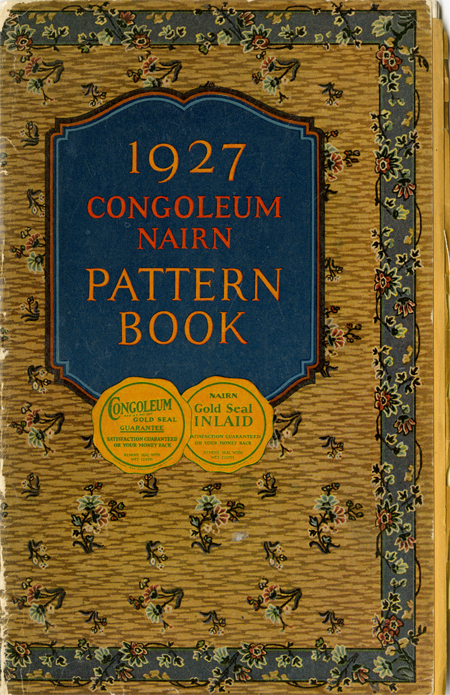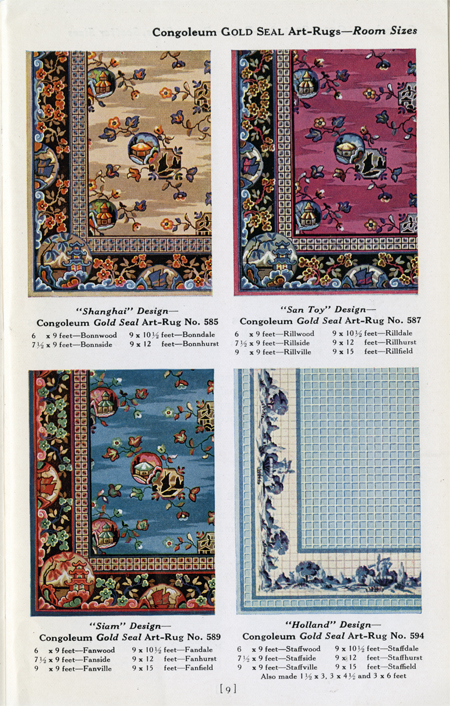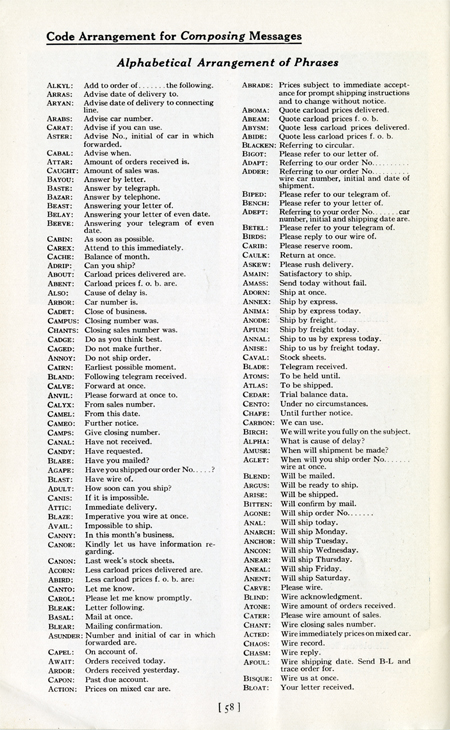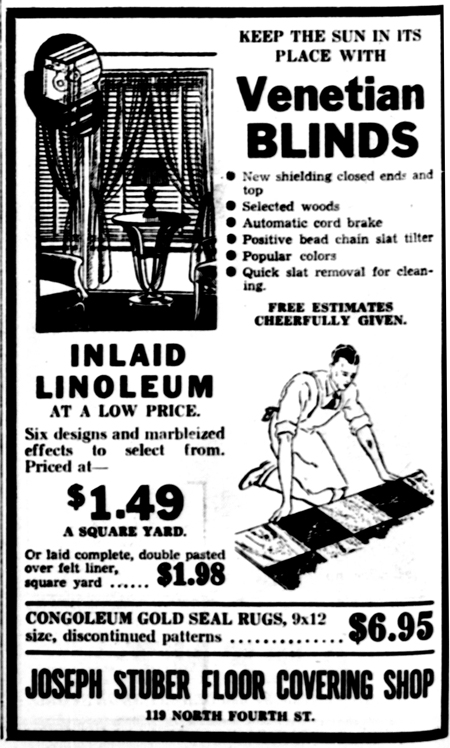
This Will Floor You
(written by Dr. Les Crocker, Emeritus Professor of Art History)
A pattern book from the Congoleum Nairn company dated 1927 and used by the O. J. Oyen company has recently been donated to the La Crosse Public Library Archives. A rather mundane object to most people, it provides a wonderful insight into floor coverings and people's preferences almost a century ago.

This pattern book was originally owned by the Odin Oyen Decorating Firm in La Crosse
People have been covering floors, or the lack of floors, since people moved into dwellings. Reeds, and similar long grasses were used in ancient Egypt and are still used in many parts of the world today. Dried moss and, animal skins were in use long before wool carpets appeared in the late Medieval and early Renaissance world. Laid down in the summer and fall, rooms were shoveled out to the bare stone or dirt in the spring, part of the spring cleaning that seems to be a part of most cultures. Most flowers bloom in the spring so for a few weeks, flowers might be mixed with the reeds. Later in the summer aromatic plants would be added, such as different varieties of mint, flower heads, rose petals, and whatever was handy.
The invention of weaving provided a more beautiful, and more expensive, floor covering. Wool, flax and hemp could be woven into fabrics for the floor. Only the wealthy could afford woven wool rugs before workers during the Industrial Revolution began to mass produce them. But non-wool floor coverings became possible that were cheaper than the wool rugs. George Washington, probably at Martha's insistence, ordered new floor cloths from Europe soon after he returned to their home at Mt. Vernon.
Canvas became the base material for 'floor cloths', although as we will see, felt took over that role in the early 1920s. The canvas was soaked in, or painted with, various chemical concoctions that were the inventor’s secret. Linseed oil, which becomes stiff as it ages, was the most common ingredient. The goal was a water resistant, flexible material with a surface color or pattern. After the Civil War, hand painting was replaced by machine applied ink that could print the same pattern forever.
These “floor cloths” as they were called were functional in that they insulated a cold floor and made floor cleaning much easier. Merchants could charge more for patterns and colors that were more expensive. As a result, less expensive floor coverings became part of the fashion world with new patterns released every few years and old patterns and color schemes discontinued.
About 1912 the Congoleum company began using felt instead of canvas as the base for its products. Felt could be produced in any desired thickness, whereas thicker canvas was more expensive to produce and had a much rougher surface. In fact, Congoleum produced three different thicknesses depending on the anticipated foot traffic in that area. Today we use rubber pads under our carpets to prolong its life, whereas the Congoleum company used felt for its springy quality.
The 1927 date of this Pattern Book is important because it shows what was available at the end of the great expansion of middle-class wealth, just before the stock market crash and the Great Depression began. This level of middle-class wealth would not exist again until the early 1950s, more than twenty years later.
Congoleum wasn't producing traditional linoleum. They were imitating woven rugs from Gobelins, Aubusson or the English weavers. Their use of felt backing and a very decorative pattern brought their Gold Seal Art Rugs into the living and dining rooms of middle-class America. In 1927 three were 32 patterns available in the Art Rug line, each pattern was available in different background colors so there were over a hundred possibilities.
Japanese art had briefly flourished in the 1890s in the Aesthetic, Japonaise and Art Nouveau styles but Congoleum presented a more general “Eastern” style that had elements from several different regions.

Shanghai, San Toy and Siam show the same pattern in three different color combinations
The Art Rugs were individual sheets in standard sizes, usually with a wide border that could be trimmed to fit odd shaped rooms. The Nairn line was less expensive with repeated patterns in roll linoleum so you could order whatever size you wanted in length but with only a standard width. The Pattern Book doesn't say how many patterns are available in the Nairn line but says almost a hundred new patterns were added in that year.

Three different patterns in different color combinations
In La Crosse linoleum first appears in the 1907 city directory being sold by the Nelson Carpet Co at 206-208 Main and Anderson Carpet at 220 Main. Anderson also sold oil cloth, matting, carpets and window shades as well as linoleum. Nelson is listed in the 1915 city directory as A. R. Nelson House Furnishing Co. still at 206-208 Main selling rugs, curtains and linoleum. His firm continued into the mid 1920s.

A modular pattern of 1, 2, and 4 units is shown in five different versions including different colored recessed mortar joints in roll linoleum
Today stone patterns in vinyl flooring are surprisingly three dimensional. Congoleum's product was probably imitating a system of using small stone chips in a concrete matrix.

Granite patterns 501, 505 and 515
There are five types of wood flooring imitated in the Gold Seal rug line. They could be used as a border around your smaller center rug or as the entire floor.

Rug borders that imitate wood inlaid and wood grain
Linoleum has never quite decided what it is. The catalog contains many patterns taken from ceramic tiles of the time. White glazed tiles in rectangular, hexagonal, and octagonal shapes were the standard in bathrooms across America. Ceramic tile in the kitchen might be easy to clean but it was slippery. Congoleum gave you the look of tile but had enough surface texture not to dump you on your fanny while carrying a pot of boiling sweet corn to the table.
Ceramic tile, wool rugs, inlaid wood, granite chips all were part of Congoleum's line of floor coverings that imitated more traditional materials and gave everyone more choice of designs and prices. It was one of the earliest mass-produced synthetic material.
Today our houses are sheathed in steel, aluminum and plastic panels of fake clapboards with impressed wood grain. Brick and stone panels a quarter inch thick imitate the traditional materials that sheltered humans. Panels of compressed sawdust mixed with resins are surfaced with photo-lithographs of wood and made into furniture. Marble dust from the quarries of Italy is made into new stone. We have granite counter tops that never touched the earth.
Linoleum was one of the earliest products to significantly improve life in working-and middle-class households. It was mass produced in standard forms but the technology allowed the patterns to be changed. It was a good product for the money as the company’s continued existence indicates.

A code is found! A conspiracy revealed!
Surprisingly, the booklet also included two pages of code words. Nothing nefarious or secretive just good economics. Telephones were still not universal in 1927, especially in small towns, but any town that had a railroad station also had a telegraph. Thus, instructions could be delivered in hours rather than the days it would take to send a letter. Telegrams cost by the word, so abbreviations and codes saved the company and the client money.
--
"CARIB CANIS CADGE CAULK"
↓
I told you to “reserve a room but if it was impossible then do as you think best. Return at once.”
--
Four words instead of sixteen, “a” was often a “free” word. Faster and cheaper communication made for more sales. The La Crosse stores were probably taking orders from small town hardware stores and bunching them to send to the regional warehouse in Minneapolis. With orders shipped by train to La Crosse, customers should have gotten their order within a week, I would guess, if the pattern was on hand. Otherwise it might be shipped from Chicago, as directed by telegram code. The La Crosse distributor would send the linoleum to the smaller towns to be picked up at the railroad station and any storage fees paid by the buyer.
Unfortunately, the price list was not with the pattern book since prices might be raised or lowered as needed. They were usually an insert in catalogs.

While this La Crosse Tribune ad is ten years after the Congoleum Nairn Pattern Book was published, note the difference in the price per square foot of linoleum installed versus uninstalled. Stuber’s also advertised Congoleum brand rugs. La Crosse Tribune, Nov. 4, 1937, p15
